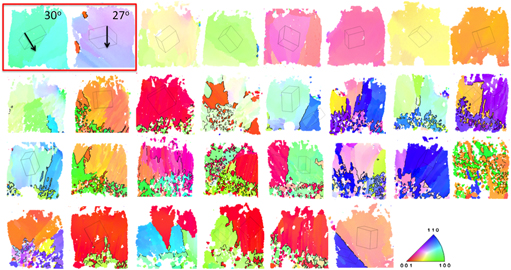Crossref Citations
This article has been cited by the following publications. This list is generated based on data provided by
Crossref.
Chen, Hongtao
Li, Jue
and
Li, Mingyu
2012.
Dependence of recrystallization on grain morphology of Sn-based solder interconnects under thermomechanical stress.
Journal of Alloys and Compounds,
Vol. 540,
Issue. ,
p.
32.
Chen, Hongtao
Yan, Bingbing
Yang, Ming
Ma, Xin
and
Li, Mingyu
2013.
Effect of grain orientation on mechanical properties and thermomechanical response of Sn-based solder interconnects.
Materials Characterization,
Vol. 85,
Issue. ,
p.
64.
Wang, Yiwei
and
Ho, Paul S.
2013.
Mode II electromigration failure mechanism in Sn-based Pb-free solder joints with Ni under-bump metallization.
Applied Physics Letters,
Vol. 103,
Issue. 12,
Kim, Youngseok
Nagao, Shijo
Sugahara, Tohru
Suganuma, Katsuaki
Ueshima, Minoru
Albrecht, Hans-Juergen
Wilke, Klaus
and
Strogies, Joerg
2014.
Enhanced reliability of Sn–Ag–Bi–In joint under electric current stress by adding Co/Ni elements.
Journal of Materials Science: Materials in Electronics,
Vol. 25,
Issue. 7,
p.
3090.
Ma, Limin
Zuo, Yong
Guo, Fu
and
Shu, Yutian
2014.
Effects of current densities on creep behaviors of Sn–3.0Ag–0.5Cu solder joint.
Journal of Materials Research,
Vol. 29,
Issue. 22,
p.
2738.
Kim, Youngseok
Nagao, Shijo
Sugahara, Tohru
Suganuma, Katsuaki
Ueshima, Minoru
Albrecht, Hans-Juergen
Wilke, Klaus
and
Strogies, Joerg
2014.
Effect of electromigration on mechanical shock behavior in solder joints of surface mounted chip components.
Japanese Journal of Applied Physics,
Vol. 53,
Issue. 4S,
p.
04EB02.
Hsu, Wei-Neng
and
Ouyang, Fan-Yi
2014.
Effects of anisotropic β-Sn alloys on Cu diffusion under a temperature gradient.
Acta Materialia,
Vol. 81,
Issue. ,
p.
141.
Parks, Gregory
Faucett, Austin
Fox, Craig
Smith, Jake
and
Cotts, Eric
2014.
The Nucleation of Sn in Undercooled Melts: The Effect of Metal Impurities.
JOM,
Vol. 66,
Issue. 11,
p.
2311.
Kim, Youngseok
Nagao, Shijo
Sugahara, Tohru
Suganuma, Katsuaki
Ueshima, Minoru
Albrecht, Hans-Juergen
Wilke, Klaus
and
Strogies, Joerg
2014.
Refinement of the Microstructure of Sn-Ag-Bi-In Solder, by Addition of SiC Nanoparticles, to Reduce Electromigration Damage Under High Electric Current.
Journal of Electronic Materials,
Vol. 43,
Issue. 12,
p.
4428.
Parks, Gregory
Lu, Minhua
Perfecto, Eric
and
Cotts, Eric
2014.
Controlling the Sn grain morphology of SnAg C4 solder bumps.
p.
690.
Albrecht, H.-J.
and
Strogies, J.
2014.
Investigations studying the electromigration phenomena in interconnects.
p.
1.
Kim, Sang-Hyuk
Hong, Seong-Ki
Yim, Hyunho
and
Lee, Hyo-Jong
2015.
Characterization of the SnAg Electrodeposits according to the Current Density and Cross-sectional Microstructure Analysis in the Cu Pillar Solder Bump.
Journal of the Korean institute of surface engineering,
Vol. 48,
Issue. 4,
p.
131.
Liu, Pilin
Overson, Alan
and
Goyal, Deepak
2015.
Key parameters for fast Ni dissolution during electromigration of Sn0.7Cu solder joint.
p.
99.
Shen, Yu-An
and
Chen, Chih
2015.
Study of grain size and orientation of 30 µm solder microbumps bonded by thermal compression.
p.
204.
Ho, C.E.
Yang, C.H.
Chen, C.T.
and
Chen, B.Z.
2015.
Abnormal depletion of Cu metallization pads in line–bump–line solder joints under electron current stressing.
Thin Solid Films,
Vol. 596,
Issue. ,
p.
216.
Chen, Chih
Yu, Doug
and
Chen, Kuan-Neng
2015.
Vertical interconnects of microbumps in 3D integration.
MRS Bulletin,
Vol. 40,
Issue. 3,
p.
257.
Chen, Hongtao
Hang, Chunjin
Fu, Xing
and
Li, Mingyu
2015.
Microstructure and Grain Orientation Evolution in Sn-3.0Ag-0.5Cu Solder Interconnects Under Electrical Current Stressing.
Journal of Electronic Materials,
Vol. 44,
Issue. 10,
p.
3880.
Chen, Jian-Qiang
Guo, Jing-Dong
Ma, Hui-Cai
Liu, Kai-Lang
Zhu, Qing-sheng
and
Shang, Jian Ku
2015.
Magnetic-field induced anisotropy in electromigration behavior of Sn–Ag–Cu solder interconnects.
Journal of Materials Research,
Vol. 30,
Issue. 8,
p.
1065.
Mertens, J.C.E.
Kirubanandham, A.
and
Chawla, N.
2016.
Electromigration mechanisms in Sn-0.7Cu/Cu couples by four dimensional (4D) X-ray microtomography and electron backscatter diffraction (EBSD).
Acta Materialia,
Vol. 102,
Issue. ,
p.
220.
Bashir, M. Nasir
Haseeb, A.S.M.A.
Rahman, Abu Zayed Mohammad Saliqur
and
Fazal, M.A.
2016.
Effect of Cobalt Doping on the Microstructure and Tensile Properties of Lead Free Solder Joint Subjected to Electromigration.
Journal of Materials Science & Technology,
Vol. 32,
Issue. 11,
p.
1129.
